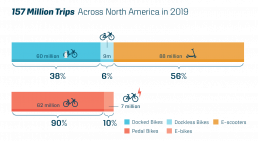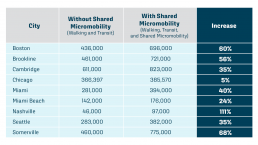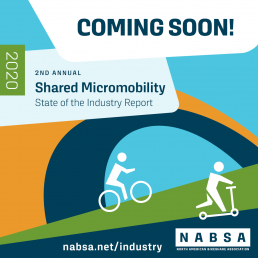2020 Report Coming Soon!
A Look Back at the 2019 State of the Industry
Over the last 14 years, the shared micromobility industry has grown from a handful of city bikeshare programs to a complex ecosystem of bikeshare and shared e-scooter systems with a wide variety of vehicle types, system models, and ownership configurations. Cities have come to rely on shared micromobility as an integral part of the transportation network, increasing transportation options and contributing to environmental, equity, and public health goals.
In 2019, NABSA released the first Shared Micromobility State of the Industry for North America. We’re excited to partner again with Toole Design and UC Berkeley’s Transportation Sustainability Research Center to continue developing this annual and vital industry resource. The 2020 Shared Micromobility State of the Industry Report for North America will feature updated metrics from the 2019 report, while also highlighting new data and the industry’s response to the COVID-19 pandemic. The 2020 report is scheduled to be released later this summer!
In preparation for the release of the 2020 report, we’re looking back at some of the data and benchmarks from the 2019 report.

Ridership
In 2019, at least 292 cities in North American had at least one shared micromobility system, including 264 cities in the United States, 17 cities in Mexico, and 11 cities in Canada. Riders in these countries took an estimated 157 million trips across 194 thousand vehicles. The average trip was 1.3 miles and 23 minutes long.

Jobs
NABSA estimated that in 2019 the shared micromobility industry had generated direct employment of approximately 5,000 full-time equivalent jobs in North America at city and government agencies, operating companies and nonprofits, equipment vendors, and planning and engineering companies.
Studies conducted by the Micromobility Coalition and DePaul University show that access to shared micromobility substantially increases the number of jobs people can access without a car within a 45-minute commute. For example, Boston residents could access 436,000 jobs in 45 minutes or less through transit or walking. However, that number increases by 60% to 696,000 when shared micromobility is an option.

Community Benefits
User surveys show that 36% of shared micromobility rides replaced a car trip and that 5% of trips are new trips that residents wouldn’t have taken otherwise. This shift in the mode of transportation resulted in offsetting approximately 65 million pounds of carbon dioxide emissions by replacing car trips. Additionally, this mode shift resulted in 30 million hours of additional physical activity by creating new trips or replacing motorized trips. Reducing greenhouse gas emissions and improving community health are common goals for city officials in North America. The 2019 report painted a clear picture of how shared micromobility helps achieve these goals.

What to expect from the 2020 State of the Industry Report
We’re nearing the completion of the 2020 Shared Micromobility State of the Industry Report for North America and are excited for its release later this summer!
Our 2020 report explores COVID-19’s impact on the shared micromobility industry and its response and resiliency during the pandemic.
New in the report:
- A more complete estimate of jobs in the industry
- Workforce diversity initiatives
- A country-by-country breakdown of ridership
- A country-by-country breakdown of vehicle types
- Cost considerations for private operators
- Enhanced public transportation metrics including proximity to transit, transit-related trip-making, and connection to transit
The report will also provide some comparisons between 2019 and 2020 metrics.
The Shared Micromobility State of the Industry Report is a vital tool to track the industry’s trends, growth, and success. This allows us to continue to grow and improve the industry, provide benefits to communities that shared micromobility provides, and demonstrate to policymakers how shared micromobility can contribute to policy goals.
Learn more about the State of the Industry Report at nabsa.net/industry.
